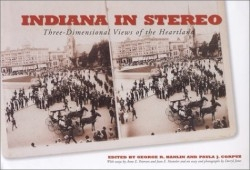
Indiana In Stereo
Three-Dimensional Views of the Heartland
A family-parents, five sons, and three daughters-poses in their Sunday clothes on the porch steps of their brick home in the early 1900s. This engaging stereograph, from the Indiana Historical Society, evokes an era when the front porch was a place where families and friends gathered on long, hot summer evenings.
In this book, the editors introduce readers to the history of stereography, a photographic process using stereoscopic equipment, which was introduced by Charles Wheatstone in the 1830s. The photos, dating from the 1860s to the 1930s, appear in three dimensions when viewed through a stereoscope. Hanlin, assistant editor at the Indiana Historical Society Press, and Corpuz, its senior editor, chose the photographs on the basis of technical quality, interest level of the subject matter, and location.
One of the photos shows downtown LaPorte, with its three-story buildings and streets lined with horses and buggies. Another depicts the scene of a fire in Greencastle: “By morning six blocks of businesses and homes had burned,” the caption reads. Also from Greencastle, a histology classroom at DePauw University in the late 1890s has a human skeleton on display.
A young couple, immaculately dressed, stands rigid, looking rather sullen. The photo was taken in 1909, and the caption indicates that they were married two years later. An entertaining photo shows two men inspecting chickens on muddy ground in front of a ramshackle building. One man is shabbily dressed; the other is wearing a suit and a bowler hat despite the dilapidated surroundings.
In a photo from the 1880s, people are seated at a picnic table in the woods. They, too, are well dressed, and the long, cloth-covered table holds a considerable amount of food. An abandoned buggy appears in another stereograph, covered in deep snow, with leafless trees standing forlorn in the background.
Anne Peterson, curator of photographs at Southern Methodist University’s DeGolyer Library, and Joan Hostetler, coordinator of the Indiana Photographers Project, have written essays detailing the development of the stereograph. “With no movies, television, radio, telephone, or computers, the advent of the stereograph was groundbreaking in terms of home entertainment,” writes Peterson.
In some of the pictures, the photographers have caught the emotions of ordinary people: boredom, grace, compassion, shyness, or indifference. These photos are a powerful and penetrating way of seeing and remembering the past. They serve as a witness to history-a compelling addition to the written record on which most historians rely. They also offer insight into the skill, passion, and intelligence of the photographers.
The book is accompanied by a handheld viewer, so readers may highlight the three-dimensional effects of these nostalgic photos, which document a time and a lifestyle long gone and forgotten.
Reviewed by
George Cohen
Disclosure: This article is not an endorsement, but a review. The publisher of this book provided free copies of the book to have their book reviewed by a professional reviewer. No fee was paid by the publisher for this review. Foreword Reviews only recommends books that we love. Foreword Magazine, Inc. is disclosing this in accordance with the Federal Trade Commission’s 16 CFR, Part 255.
